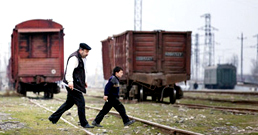After the Thaw
16.11.2011
‘After theThaw’ presents a unique and stimulating insight into the lives of people living in the former Soviet republics of Armenia, Azerbaijan, Georgia, Russia and Tajikistan. Twenty years after gaining independence from the USSR, many people have benefitted from the great transition while millions still live in poverty.
The months between August and December 1991 bore witness to the dissolution of the USSR and signaled the end of an era in the world history. The conclusion of the Cold War held the promise of a new future. Power flowed from the monolithic Soviet state to the burgeoning independence movements in its fifteen constituent republics. There was hope among these peoples that for the first time they, and not just the political elite, would be able to enjoy the fruits of their labours.
The reality of the transition from communism differed markedly from this ideal. Promised economic and political renewal became manifest in some former Soviet republics, but not in others. A number of people across the region benefitted from the introduction of competitive markets and free enterprise, but many more struggled to adjust to the new rules. The initial shock of capitalist transformation, combined with the erosion of large scale programmes of state welfare, led in many cases to growing inequality and unemployment. Such trends have proved hard to stamp out in the following years.
In many cases the ending of Soviet rule exposed unresolved territorial disputes. Since gaining independence, all of the countries featured in the exhibition have experienced conflict of one kind or another. Armenia and Azerbaijan remain locked in dispute over the Nagorno-Karabakh region; Georgia has continuing border issues with South Ossetia and Abkhazia; Tajikistan was embroiled in a brutal civil war between1992-1997; Russia sent troops into Georgia in 2008 and faces ongoing unrest in the North Caucasian republics of Chechnya,Ingushetia and Dagestan. Such conflicts have resulted in the creation of large numbers of internally displaced peoples, or 'IDPs'. These people exiles in their own countries, feature prominently in the photographs on display.
‘After the Thaw’ shines a spotlight on individuals and families in these recently autonomous nations. In some respects, the photographs reveal a growing diversity across the region. Independence brought with it a flourishing of local and national forms of cultural expression. Traditional fashions, religions and social practices were rejuvenated from a state of dormancy under the Soviet regime. From colourful Tajik dresses to painted monobrows, and prayer flags fluttering on the Tuvan hillsides-the exhibition attests to the revival of national culture.
Wealth in the region has tended to accrue only to a select few. The exhibition indicates a pervasive poverty, which- from the onion fields of Barda in Azerbaijan, to the mountainous terrain of Gelot village in Tajikistan- is particularly acute in rural areas. Village-dwellers generally have less access to adequate sanitation and clean drinking water when compared with their urban counterparts. Rising food prices in recent years have exacerbated the problem of rural poverty and have brought with them attendant troubles of malnutrition and disease as well as pressures for breadwinners to migrate in order to earn a decent living.
Twenty years ago, the fall of the Soviet Union removed a major constraint on the freedom of action and expression for millions of people. Today, constraints exist in other guises, predominantly economic. The overall picture presented by 'After the Thaw' is stark and sober, but also hopeful.
Source: Oxfam


